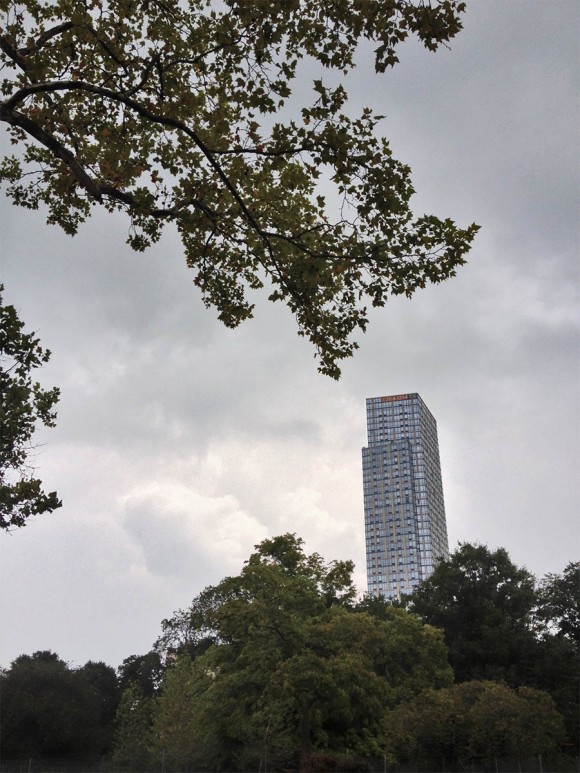Super-slender residential skyscrapers are taking to the skies south of Central Park. They are an increasingly brazen display of economic inequalities and a seizing of one of the world’s most distinctive skylines by the super-rich.
Midtown zoning plans on display at the Skyscraper Museum, New York
New York has a long history of slender buildings. The Bush Tower of 1917 as well as the 1897 Gillender Building tested technological boundaries of what was statically possible. As with the Gillender Building, however, most of them ended up being too small to provide meaningful office space. This largely made them economic failures.
“SKY HIGH & the logic of luxury”, the current exhibition in New York’s Skyscraper Museum, provides the narrative of the recent revival of these super-slender buildings in New York. Advances in statics and construction design have made slenderness ratios approaching 1:20 (base divided by height) technically feasible.
Yet such buildings remain expensive to build on a square foot basis. In a godsend for local developers and international starchitects (and despite the Lehman crash), the luxury market in New York is going through the roof. Jaw-dropping prices for real estate provide the incentive to build higher while slimming down at the same time: After all, 360-degree views of one of the most distinctive cityscapes are only possible if you own the whole floor.
And the super-rich increasingly want to live in central areas, many of which have been turned around following investments into public space. The Hudson Yards will border Chelsea and the hip new High Line. One Madison benefits from a revitalised Madison Square Park at its doorstep.
One Madison
At the same time, a potentially pristine view across Central Park has given birth to the 57th Street Phenomenon, several pencil-like developments planned in short distance to each other a few blocks south of the park.
The Skyscraper Museum exhibition is small and easy to digest. A quick history of the super-slender building is given in the first ten or so panels before the visitor enters the main room with various of the current projects’ models on display.
Most developers cooperated with the exhibition and, along with the models, provided other visual material, especially renderings and floor plans. A wind model of possibly the most ambitious (or audacious depending on your point of view) of the projects, 432 Park Avenue, illustrates what technological boundaries are crossed in designing buildings like these.
One 57, the tallest residential building in the Western hemisphere (until the opening of 432 Park Avenue, that is)
Penthouses at the top of these slim skyscrapers can cost tens of million US dollars. The tallest currently planned project on 432 Park Avenue is designed to have 128 units which along with some commercial real estate in the bottom floors are expected to fetch the developer USD 2.5 billion.
Apart from documenting the economics of the sky-high boom in an interesting info graphic, the Skyscraper Museum’s exhibition does not offer a critical perspective. Similarly, the bulk of coverage around the web focusses either on the “wow effect” of slick renderings or the technological aspects of building super-slenderly.
However, a critical public is needed, also because the review process for building permits is surprisingly lax. Many buildings going up at the moment are being constructed “as-of-right”, i.e. without public consultation and environmental studies.
But these projects are more intrusive than the slender size of the buildings may suggest. Frequently, developers buy adjacent plots to increase air rights for their buildings and plots along the view line towards a particular sight such as Central Park to avoid being blocked out.
Starting simply, in a city as dense as New York, more tall buildings mean less sunlight. The renderings on this site give an impression of how shadow conditions will change in the southern Central Park area. It’s going to be darker (along thin shade lines) and New York’s skyline is going to change quite radically.
432 Park Avenue
Despite their apparent fragility and slenderness that is so striking when looking at their models on display at the Skyscraper Museum, these buildings are not non-invasive.
Originally “owned” and raised towards the sky by a changing guard of Main Street and Wall Street, New York’s skyline is now increasingly punctuated and redesigned by the super-rich.
New York by Gehry at 8 Spruce Street as seen from 140 Broadway. Favourably received by architecture critics, the tower only recently lost the crown of tallest residential building in the Western hemisphere to One 57
They had until now been more reserved in their display of wealth. They made do with huge apartments in normally-proportioned Upper East Side apartment buildings. Their larger-than-life architectural manifestations were reserved for residential homes in quiet and fenced-off places safely tucked out of town.
In New York, a new architectural form is being created to drive a visual and spatial wedge between the super-slender super-rich and the rest, i.e. the majority of New Yorkers and their guests.
Uncomfortably similar to Mukesh Ambani’s Antilia in Mumbai, these new super-slender residential towers will act as a constant reminder to those down on the streets, in Mumbai’s slums or in Central Park and on the High Line, that their cities and their countries are producing unprecedented levels of economic inequality.
Foreboding: the black Trump Tower (2001) dwarfing the nearby United Nations building (1952), Le Corbusier’s sole work in the Big Apple
The trend does not stop in Midtown. Although not technically super-slender, the towers 2628 Broadway (99th Street) and 5th Ave / 102nd Street (above) show that tower economics works all the way up to 100th Street
New York by Gehry, as seen from Brooklyn Bridge with 1 World Trade Center









